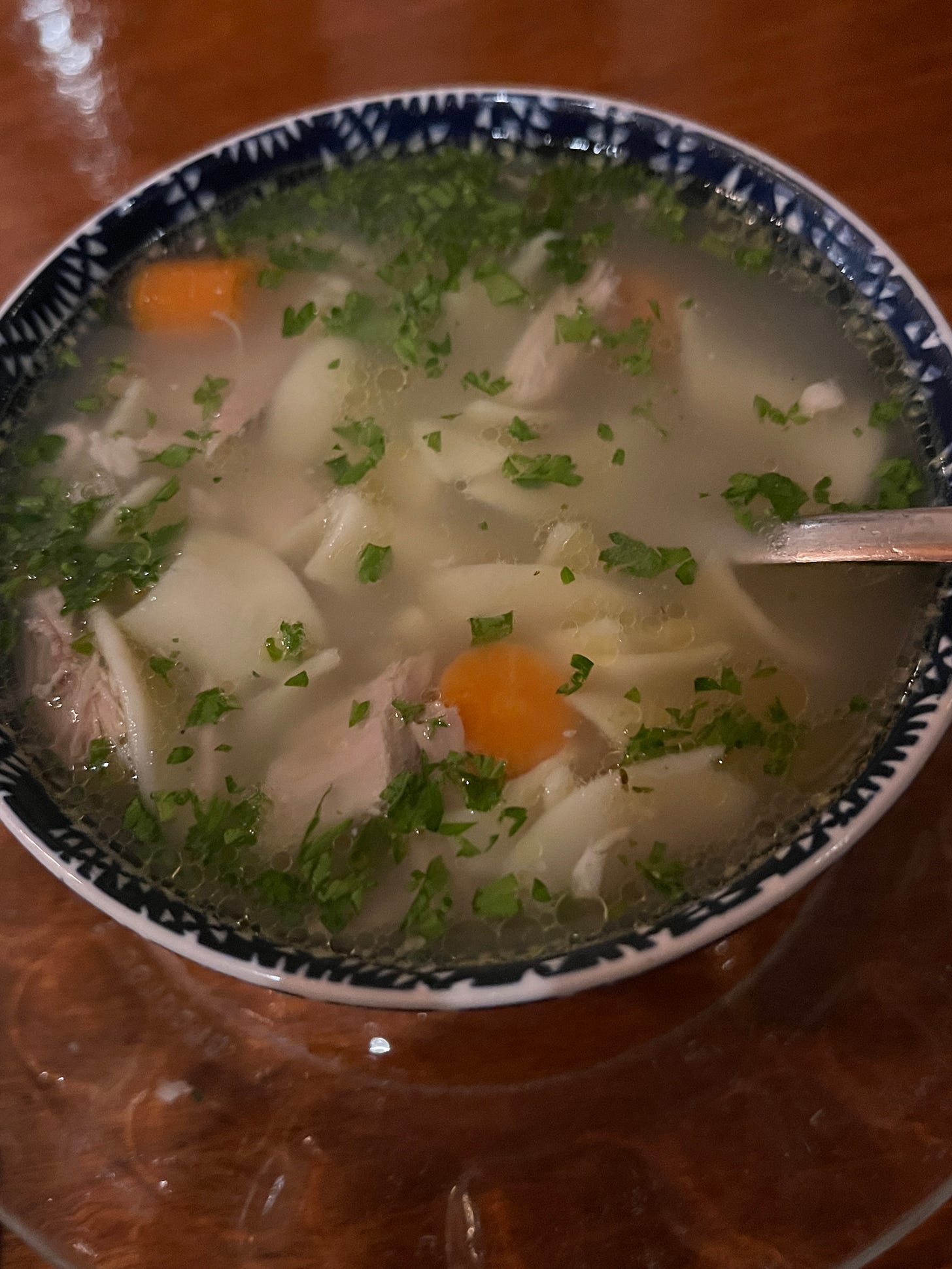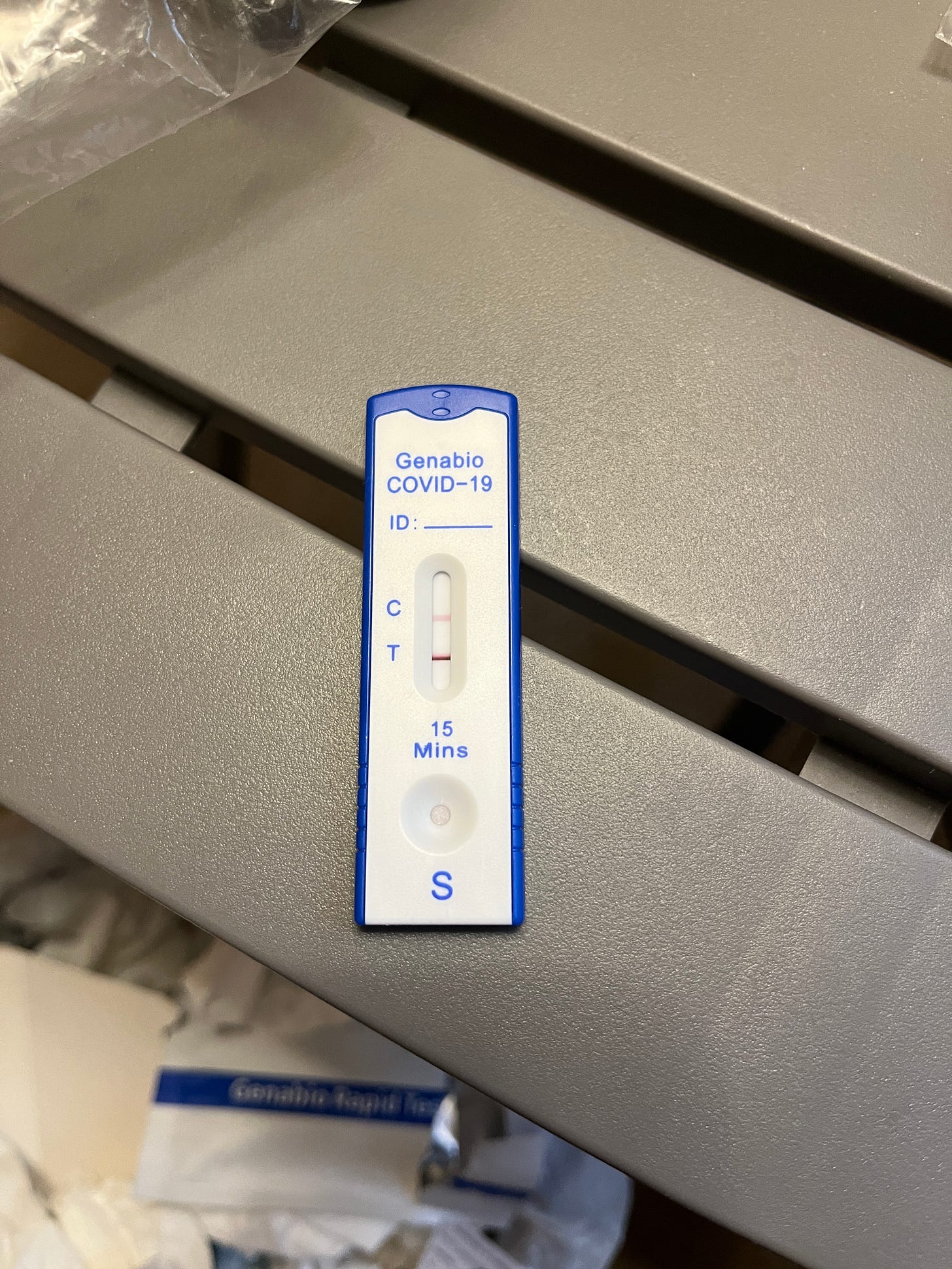Dining with Covid
What to Eat when you are Down for the Count
It must have been the travel from the East Coast the weekend before Halloween. I was not vigilant about wearing my mask on the plane, letting it flap around while I chatted with a seatmate. Plus, I had already gotten the latest booster, which made me feel invulnerable.
But it’s not over, folks. The day after our Halloween dinner party (sorry guests) I started to have cold symptoms. Nothing serious. Just sneezing, mild sore throat, nasal congestion. It’s just a cold, right? I tested at home on Wednesday and was negative but felt worse on Thursday. Friday I got up and tested and saw the positive result on the at-home test. I had dodged the bullet for almost 4 years but my time was up. I went immediately to the local Urgent Care here in Alpine where they confirmed the test and handed me a 5-day supply of Molnupiravir.
There’s never a good time to get sick and this was no exception. It meant I was unable to care for the grandkids while our daughter was on a work trip. Since that is why I am here in Wyoming it was a huge bummer.
One saving grace was that I had started a batch of chicken soup on Wednesday to fight my “cold.” When I took to my sickbed, John finished it up and that was very handy to have on hand. Especially once John went down on Saturday with symptoms. The double whammy.
Having a nourishing soup on hand is a great defense when you are sick. Simply put some in a bowl and heat it in the microwave. The oddest part of my Covid, so far, is the lack of any sense of smell. I knew he was making the chicken soup but I couldn’t detect any aroma. I let my head hang over the bowl, the steam wafting into my face, no scent. When I sipped it, the soup was warm and silky but the flavor was more from memory than from apprehending it in the moment.
With appetite diminished by the virus, you must sometimes make yourself eat so that you don’t feel too weak. Your body is fighting hard and needs energy. Soup is a perfect solution. We were lucky because we had several soup options—the black bean from our Halloween dinner and a Potato Leek soup that was prepared by Stephen’s mom, Nancy Scherba, for our welcome-back dinner. We had a virtual soup menu to choose from, all quick and easy. I counted my blessings.
Covid is not over and the best offense is a good defense. Fortify yourself with soup.
Here are a couple of little articles about soup that I used in my original posts of How to Eat and Drink back in 2014.
The Ten Commandments of Soup (with some small adaptations)
I. Thou shalt not open a can
II. Thou shalt make stock from real ingredients and water— not cubes.
III. Chicken soup comes from chicken bones, cold water, vegetables and herbs .
IV. Beef bones must be roasted first before adding the other stock ingredients.
V. Thou shalt skim the scum that rises!
VI. Thou shalt not be in a hurry or the stock will be cloudy.
VII. Finished stock is a head start for any soup.
VIII. Thou shalt choose thy vegetables wisely! Leave out the red cabbage or you will have a blue stock.
IX. Thou shalt keep in mind how long it takes to cook each vegetable.
X. Homemade soup and homemade bread are the keys to the kingdom of heaven.
I found this many years ago on the internet but never made note of the source. If it is yours, thank you! I applaud your sense of humor. I tried to add it to my Cook Like a Chef camp manual but the idea was swatted down by the federal government editors who were afraid that I would "offend" someone. It's a sad world where you can't add a little levity to your materials. But all the points are good, though, it is true, sometimes we need to rely on packaged stock and during those emergency times, be sure to use one that is reduced in sodium. There are decent ones out there and if it means that more people make soup at home, then blessed are the shortcuts! It is all okay if you are in control of what you choose to consume and can gain ownership of your pot and the health benefits of that miraculous steam rising and tantalizing all in your kitchen. Blessed are the soup makers!
And here is another vintage soup article from the same era
This is the tray that my mom used to serve me chicken soup when I was a child home sick from school. My brother, Geoff, was often sick at the same time, and I remember playing the Coast to Coast game on the back of the tray. I believe that my travel longing stems from those happy hours zipping back and forth across the country on both the northern and southern routes. We spent hours dreaming about St. Louis and Chicago, Boise and Portland. Of course, the prize was always landing in San Francisco—and isn’t that everyone’s dream still today?
Chicken soup has curative powers with versions in every culture. In Colombia, Bogata is famous for Ajiaco, which is a chicken soup with corn, potatoes, avocado, capers, and a dollop of cream. The French typically serve the stock as bouillon or consommé seasoned with bay leaves, fresh thyme, dry white wine, and garlic. In Germany, chicken stock is fortified with spices and spaetzli while in Greece, the egg-lemon soup is known as Avgolemono, and the eggs and lemon thicken the broth considerably resulting in a tangy, creamy soup. European Jews drop matzoh balls in their dill-enhanced broth and Peruvians enjoy a heartier Caldo de Gallina, with whole pieces of chicken. In Portugal and Brazil, chicken soup is known as Canja and is served with rice or pasta.
Naysayers that objected to the Ten Commandments of Soup in the kids’ cooking manual would no doubt object to my reference in my book, Seasons of Central Pennsylvania, to my sister-in-law Barbra Quinn’s recipe for Chicken Soup as Jewish Penicillin.
Update:
When my sister-in-law Barbra Quinn found out I was down with Covid she texted “Wish I could make you some chicken soup!” Here is her recipe.
Barbra Quinn’s Jewish Penicillin
1 whole chicken, cut up
3 to 4 chicken feet (or substitute chicken wings or necks)
1 bunch parsley
1 bunch fresh dill
1 or 2 parsnips
1 or 2 turnips
2 carrots
1 onion, cut in half with outer brown skin left on1
2 stalks celery
1 to 2 teaspoons salt
1 teaspoon whole peppercorns
Place chicken pieces in a large pot and cover to over 1 inch with cold water. Simmer, skimming the scum that rises, for half an hour. Add the remaining ingredients and cook slowly for 2 and 1/2 hours. Skim the fat from the top, strain the soup and debone the chicken parts when cool enough to handle. Peel and chop whatever vegetables you would like to return to the broth. Add chopped chicken and vegetables to broth and reheat to serve.
*Tip*
Frozen chicken feet are available at Asian markets. They are also available from Kosher butchers and, of course, from farmers that raise and sell their own chickens. Chicken wings or necks are also a good substitute and will help to make a gelatinous stock because of increased collagen content.
*Cook’s Note*
The terms broth and stock are used interchangeably. A broth is defined as a flavorful liquid made by simmering meats and/or vegetables. A stock is defined as a clear liquid flavored by soluble substances extracted from meat, poultry, and fish, and their bones, and from vegetables and seasonings.








